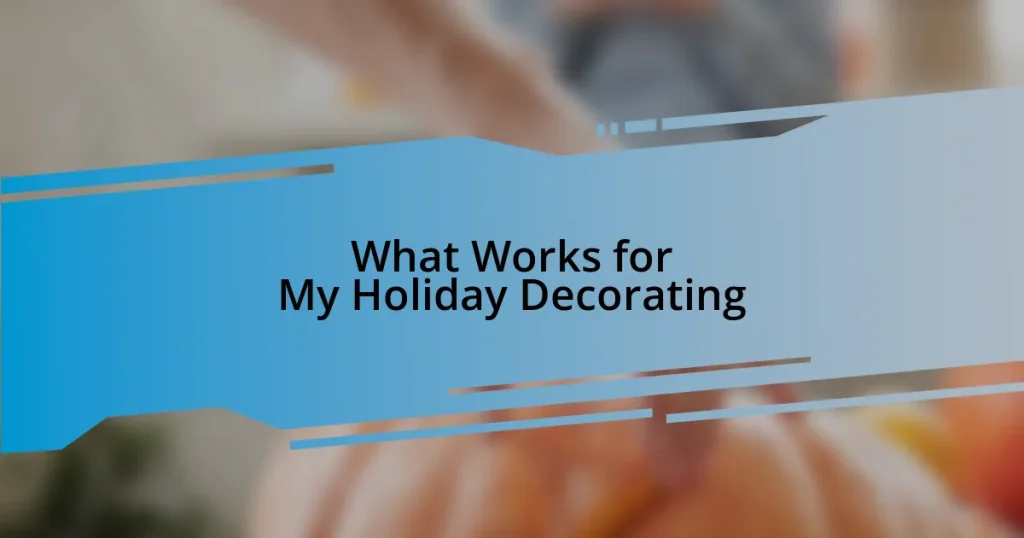Key takeaways:
- Choosing craft items that resonate with the audience and prioritizing practicality helps establish deeper connections and boosts sales.
- Designing an engaging booth display with attention to color, height variation, and thematic arrangement enhances customer attraction and interaction.
- Effective customer engagement through genuine interactions and a comfortable environment fosters relationships, leading to increased sales and repeat business.

Choosing the Right Craft Items
When I began curating items for my first craft booth, I quickly learned that selection is everything. I found myself asking, “What resonates with my audience?” I tapped into local trends and my own passions to create a blend that felt authentic and inviting.
One memorable experience was when I decided to include handmade journals alongside my usual crafts. I had no idea how popular they would be! The joy on customers’ faces as they flipped through the pages made me realize that choosing items that allow for personalization can foster a deeper connection with my audience.
I also discovered that practicality matters. While it’s tempting to showcase only my most intricate pieces, I found that simpler, more functional items often caught the eye first. Asking myself, “What do people need and want?” helped me focus on creating items that not only look good but also serve a purpose in everyday life.

Designing an Eye-Catching Display
Creating an eye-catching display was an essential part of my craft booth’s success. I remember pacing before the show, feeling a mix of excitement and anxiety, thinking, “How can I turn this simple table into a visual feast?” I opted for vibrant colors and varied heights to draw attention, making sure each piece flowed together seamlessly. My inspiration came from visiting other booths, where I jotted down what caught my eye. It was clear to me that a well-designed display not only showcases products but also tells a story.
To keep your display engaging, consider these elements:
– Color Palette: Choose colors that evoke emotions and complement your products.
– Height Variation: Use risers or stands to create different levels. This draws the eye and adds depth.
– Clear Signage: Make sure your prices and brand name are easy to read.
– Thematic Arrangement: Group similar items together to create a cohesive look.
– Interactive Elements: Incorporate touch-friendly items or demos to encourage customer interaction.
– Lighting: If possible, utilize lamps or fairy lights to enhance visibility and ambiance.
These strategies not only helped me attract attention but also made the space feel welcoming and inviting, a reflection of my craft style.

Setting Up Your Craft Booth
Setting up your craft booth was a learning journey for me, and I truly enjoyed the process. I remember arriving early on setup day, feeling a rush of adrenaline and anticipation. The first thing I did was lay out my tablecloth—selecting one in a warm, inviting hue changed the entire mood. It’s funny how such a simple choice made everything feel more professional and approachable. After I arranged my items, I took a step back, observing how everything interacted visually. Did the colors complement each other? Did my favorite pieces stand out? Those moments of reflection are crucial.
As I began arranging my displays, I realized the importance of flow. I wanted customers to experience my booth naturally, moving seamlessly from one item to the next. At one show, I laid my products out in a zig-zag pattern and was surprised by how many people lingered, drawn in by the inviting path. It was as if each new item piqued their curiosity, leading to conversations that I never expected. That’s when I understood: a well-thought-out setup can encourage more engagement and discussion, ultimately fostering connections.
I also learned to embrace flexibility. Early on, I committed to specific arrangements based on ideas I’d seen online, but I soon realized that reacting to traffic patterns was vital. During one busy show, I moved my best-selling items to the front after noticing they drew people in, which resulted in a quick upturn in sales. Your booth’s layout should evolve based on real-time feedback; being adaptable can significantly improve your overall experience.
| Setup Element | Tips |
|---|---|
| Tablecloth | Choose colors that evoke warmth and friendliness. |
| Layout | Opt for a natural flow that guides customers through your booth. |
| Flexibility | Be ready to adjust based on customer traffic and interest. |

Marketing Strategies for Booth Success
To truly elevate your craft booth, I discovered that marketing strategies play a crucial role. I initially underestimated the power of social media. Before my first show, I took to Instagram, sharing sneak peeks of my creations and the booth setup. I remember the buzz it created—people were excited, expressing interest even before the event. It dawned on me: leveraging social platforms not only builds anticipation but also creates an engaging community that can lead to sales on the day of the event.
Another key strategy was to encourage word-of-mouth. At one market, I offered a small discount to customers who tagged me in their social media posts. Seeing their friends share excitement about my products provided invaluable exposure. I often wonder how many businesses overlook this simple tactic. It transformed strangers into advocates overnight, and I vividly recall the surge of happiness when I spotted my work featured on a friend’s Instagram story. It felt like a warm endorsement, validating the passion behind my craft.
Lastly, consider partnering with other vendors for cross-promotion. During one event, I teamed up with a local baker, creating a small corner displaying my crafts alongside her treats. The synergy was palpable; customers were delighted by the combination, and we saw a noticeable increase in foot traffic. Have you ever tried such collaborations? The experience taught me that small, strategic partnerships can create a win-win situation, amplifying visibility for everyone involved.

Engaging with Customers Effectively
Engaging with customers effectively is a blend of genuine interaction and strategic communication. At my first craft fair, I discovered that a friendly smile and eye contact could work wonders. I still remember the joy on a customer’s face when I complimented her choice of color in a handmade item. It wasn’t just about selling; it was about connecting. Engaging in light conversation allowed me to share the stories behind my creations, making each item feel more personal and cherished.
I also found that asking open-ended questions encourages deeper interactions. Instead of simply asking if someone liked a product, I would ask, “What do you love most about this piece?” It sparked conversations that often led to insights about what customers appreciated in my work and what they were looking for in their own lives. Reflecting on these moments, I realized how important it is to listen actively. It’s not just about pushing a sale; it’s about understanding the customer and fostering a relationship.
Another lesson came from observing fellow vendors’ engagement styles. I noticed that some set up a casual seating area where customers felt comfortable lingering. Inspired, I placed a small chair next to my booth and invited visitors to sit for a moment if they liked. It created an inviting atmosphere. I still recall a touchpoint where a couple sat down and shared their story of crafting together. It was in that relaxed space that I sealed a memorable sale and established a rapport. Have you ever considered how creating a welcoming environment can influence customer interactions? Trust me, the right atmosphere transforms a simple transaction into a delightful experience.

Managing Sales and Payments
Managing sales and payments at my craft booth was one of those areas I thought would be straightforward, yet it presented its own set of challenges. I quickly learned the importance of having a reliable payment system in place. The first event I attended, I opted for a traditional cash-and-check approach—a decision that left me fumbling during busy moments. Eventually, I realized that integrating a mobile payment solution, like Square or PayPal Here, allowed me to process transactions swiftly and securely. The ease of accepting credit cards transformed my sales approach and left customers feeling confident and satisfied with their purchases.
To maintain a smooth flow during the event, I also devised a simple pricing strategy. I clearly marked prices on each item and placed a price list at the front of my booth. This not only saved me from repeated questions but also helped in creating an independent shopping experience for my customers. Have you ever stood at a booth, trying to decipher prices while waiting impatiently? I’ve been there, and it only reinforced my belief in transparency. Clear pricing made transactions feel effortless, allowing me to focus more on engagement rather than sales pressure.
Looking back on my experiences, I can’t stress enough the value of tracking sales even during busy days. I adopted a small notebook strategy to jot down each sale’s details between transactions. It helped me avoid mistakes and provided clarity on what items were popular and which didn’t resonate as much. The little notes became insights for future events, guiding me in refining my selection. Did you know that understanding customer preferences can shape your inventory for future shows? By staying organized and attentive, I not only improved my efficiency but also turned my craft booth into a more thriving business.
















